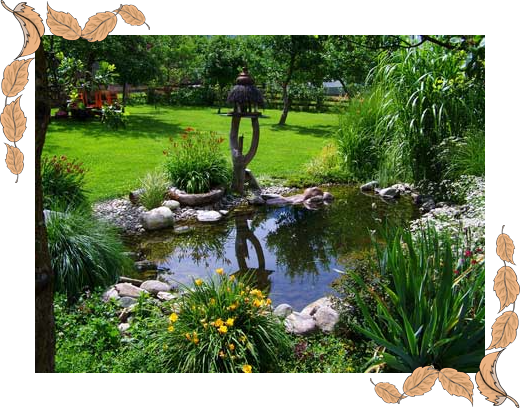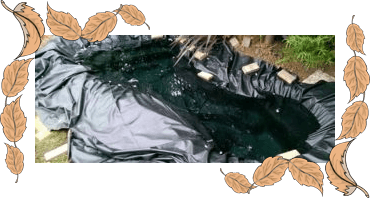A garden pond is natures oasis in amongst all the concrete of todays urban developments. Being a proud owner of a garden pond need not mean hours spent cleaning and maintaining it. Follow these tips as discussed in this article for a healthy, thriving water feature.
With urban development there is so much talk about adding in ‘green space’ – and quite rightly so, but what about ‘blue space’ which is equally important to wildlife and to our own health and well-being? We can all make a significant impact by building our own garden pond. Who loves to stare at a stretch of water and feel instantly relaxed? A garden pond is known to bring a new dimension to a homes outdoor space of any size. Water is one of the most soothing, calming and tranquil compounds. With all the positive attributes, lets build a garden pond that requires as little maintenance as possible so that you have time to tend to other jobs about the home, to relax and to take-in the marvellous creation you have built. So lets get to work to build a garden pond that will require as little maintenance as possible by keeping the water algae free and fish healthy. 
Planning phase of a garden pond build
- Where to start digging – The ideal position for a garden pond is one that will get an equal portion of both sun and shade over the course of the day. At least 5 hours of sunshine is optimal. Too much sun or too much shade both have positive and negative impacts – so they need to be carefully weighed up against each other if low-maintenance is the goal. Algae thrives in constant sunshine and waterlilies bloom and thrive in full sunshine, fish are not visible to their enemy the heron in shady conditions, fallen leaves will need to be collected before sinking to the bottom and turning to sludge – or install a skimmer to stop leaves landing in your pond.
- Impact of slopping versus flat ground – before you put your spade into the ground you need to also make sure there will be no run-off into your pond once it is filled and inhabited. A heavy rain down pour could potentially bring with it weed killer, fertilizer, garden debris and other toxins which could affect water quality and the health of your fish – a big maintenance project would lie ahead as a result. The flatter the piece of ground upon which you intend building the better. One alternative if rain run-off is a big concern is to build a raised pond. The other, easier option when you dig your pond, is to make sure the ground around the perimeter of the hole is about 3 inches (8 cm) above the surrounding soil. If you’re building in a low spot that becomes water-logged during heavy rains, make the perimeter or edge a bit higher. The two images provide a good example of a raised edge to the pond:
- Depth of dug-out – how deep you go has an impact on the healthy and safety of fish as well as aquatic plants which need depth to grow. The ideal would be to go down 3 to 5 feet (1.5 meters) for fish to gain enough depth to hide from the hungry bill of a heron.
- Size does matter – the bigger the pond the better. There are many reports by pond owners who will confirm this fact. The bigger a pond, the more water it can hold. The greater the volume of water, the more fish and aquatic plants that can be housed. Fish and aquatic plants compliment each other to create a perfect ecosystem, the result of which is a low maintenance garden pond.
- Shape to avoid stagnation – the first question to ask yourself is whether you want a formal or informal (natural) garden pond. Lining a pond with a PVC or rubber pond liner will allow for maximum design flexibility. Most home-owners take the landscape of their garden and surroundings into consideration when deciding on shape and style. The design needs to allow for good water circulation and therefore is best to avoid corners in your design – unless installing a box-welded or tailored to fit pond liner for an ornamental design. Avoiding water stagnation keeps pond maintenance to a minimal.
- Invest in a high quality pond liner – a low maintenance pond surely wants a pond liner that lasts for at least 25 years to avoid having to carry out repair work or drain your pond to reline it. A hard wearing, durable pond liner will be worth the investment. Most pond experts recommend 0.75mm Epalyn (EPDM) rubber pond liner. Most pond liner retails will offer a pond liner guarantee if a protective underlay is installed to prevent ground movement pushing sharp edged stones up to the surface and potentially puncturing the pond liner.
Once all these steps are in place, we recommend reading the following guide to digging your pond and installing the protective pond underlay and pond liner – Pond Planning, Construction and Pond Liner Installation







I do trust all of the concepts you’ve presented to your post. They’re really convincing and can definitely work. Nonetheless, the posts are too short for starters. May you please lengthen them a little from next time? Thanks for the post.
It’s really a cool and helpful piece of info. I’m glad that you shared this useful info with us. Please keep us up to date like this. Thanks for sharing.
whoah this blog is excellent i love reading your posts. Keep up the great work! You know, a lot of people are hunting around for this info, you can aid them greatly.